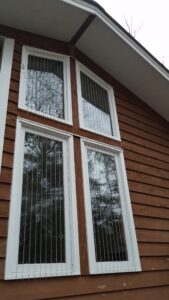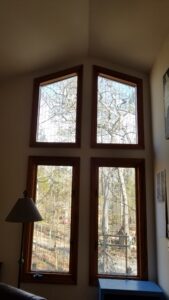Preventing that Dreaded Thump
Author: Barb Stenross
First the horrible “thump.” Then the rush to look out the addition’s windows, searching for the bird that hit, hoping it was just stunned, but also knowing that even if so, a stunned bird is more vulnerable to predators.
During our first years in the house, we never had a problem. The windows had small panes and exterior screens. But then we added a room-sized addition that jutted out into the small woodlot at the back of our half-acre Carrboro property. It had tall, narrow windows that allowed me to see my favorite tree, a hybrid post oak, from the breakfast table. Then, the bird strikes began. While the regulars knew to avoid the windows, migrating birds did not. Although we never saw a dead bird, I spent more than an hour once waiting and watching until a white-throated sparrow recovered enough to fly. And there were probably birds that didn’t make it that I just didn’t see. We had to do something.
First we bought those leaf and hummingbird decals at a wild bird store. At $20 for a set of four decals, the money didn’t go far, and they didn’t work. To be effective, I read on an Audubon website, the decals must be no more than 4 inches apart. Too many stickers!
Next we tried adding shades, but learned that “inside” solutions don’t work. When the sun is shining on the windows and reflecting the sky and trees in the yard, birds don’t see inside screens or shades, but only the sky and trees reflected on the glass—a perceived safe passage. Then I saw something I liked on a NHAS Bird Friendly Habitat yard certification visit at a historic home in Hillsborough — “Zen curtains.” Like ours, they had a glassy modern addition that invited bird collisions. I liked the window treatment so much I thought it was a design feature until the owner explained that they had made it themselves from parachute cord (paracord). (DIY and purchase information available at https://www.birdsavers.com/) The paracord Zen curtains worked well on their large windows, but when we experimented with it on our tall but narrow windows, it seemed distracting.
 Ball chain curtains from outside.
Ball chain curtains from outside. My husband had another idea. We would make something similar, but with old-fashioned ball chain—the chains used on old light fixtures and lamps. He ordered a roll of the chain from Ball Chain Manufacturing, and shopped at Lowe’s for white “headstop” strips to match the window frames. After drilling holes two inches apart in the strips, he dropped a chain the length of the windows through each one. Because our addition is up one story, we hired hire someone to climb the ladder to screw them to the top of the frames. Success! From inside the house, the chain curtains are almost invisible. From the outside, they are a barrier birds see as too narrow to navigate.
 Ball chain curtains from inside.
Ball chain curtains from inside. On our New Hope Audubon Bird Friendly Habitat yard visits, we ask homeowners a series of 11 habitat items. “Something to prevent window strikes” is on the list of wildlife habitat options needed to qualify for certification. In doing internet research for this article, I found that while roaming cats are the number one human-cause hazard for birds in the United States, bird collisions are a not-too-distant second. The numbers are almost unfathomable—bird strikes kill an average (median) of at least 600 million birds a year. About 40 percent of these are from strikes to buildings one to three stories high, which includes most homes. A recent article in the journal Science reports a loss of almost 30% of the total number of birds in North America since 1970! There are many contributing factors, major among them being habitat loss, pesticides, and cats. Window strikes are just one more possible factor in this alarming decline.
Happily, for those who do not wish to create Zen curtains, there are many solutions to bird collisions available, both for purchase and for the do-it-yourselfer. Check out American Bird Conservancy’s FAQ page for ideas. In one really inexpensive solution, posted to YouTube by a bird-lover in England, the inventor used a level as a straightedge and a glass marker to draw vertical lines on the glass, 3 inches apart. (Incredibly simple tip to prevent birds flying into window).
Birds face so many dangers. We have a catio for two formerly outside cats. (See the recent blog article on catios for more information.) And now, with the windows dressed out, we have tackled danger number two. We can enjoy watching the birds through the windows without having to fear that dreaded thump.
« Back to All Press